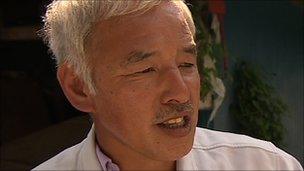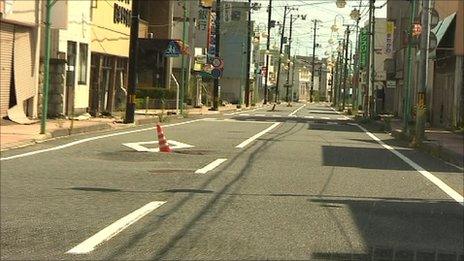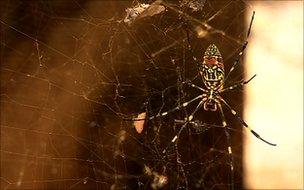Inside Japan's nuclear ghost zone
- Published
As David Shukman enters the exclusion zone, he finds cattle that have starved to death
Nothing stirs in the empty heart of Tomioka, a community of 16,000 now reduced to the eerie status of a ghost town after the nuclear disaster at Fukushima.
The shops of the main street are deserted, motorbikes and cars are abandoned, weeds push through gaps in the concrete.
Vending machines selling drinks and snacks - always popular in Japan - stand unlit and silent.
Tomioka lies just inside the 20km exclusion zone that was hurriedly enforced last March when a radioactive cloud escaped from the stricken power plant.
In the rush to flee, doors were left wide open. Windows and roofs shattered by the earthquake and tsunami are still not repaired. A bicycle leans against a lamp-post.

Mr Matsumura is eager for the world to see how his community has suffered
We are making the visit after reassurances from scientists and other journalists that radiation levels had fallen in this particular area.
The worst of the contamination was blown northwest of Fukushima while Tomioka lies to the south.
Nevertheless we equip ourselves with overalls, boots, gloves and face-masks, all designed to minimise contact with the dust that is likely to be the main source of radioactivity.
The public and media are banned from entering the zone but as we approach a police checkpoint we are not stopped.
Radiation checks
We continually operate a Geiger counter - and though the radiation level rises slightly once we cross into the zone, it is even lower than we had expected.
For the record, during the course of a three-hour visit - which we kept deliberately short to minimise the risks - the rate averages about three microsieverts per hour.
We estimate our total dose to be roughly half that of a typical chest X-ray.
Our guide is a local farmer, Naoto Matsumura, eager for the world to see how his community has suffered.
Although he was part of the initial exodus after the accident, he could not bear life in a refugee centre and soon moved back to his farm, refusing orders to leave.
He's the last citizen to remain but he believes that it's his duty to do whatever he can to keep Tomoika going as a community.

Some animals have only known life within the exclusion zone
"We want this place to be safe again," he tells me, as we drive through quiet streets and past overgrown paddy-fields.
"We need gas, electricity and water. But the old people still want to come back, even my mother and father. Their wish is to die here.
"Now it's just me taking care of the animals."
The fate of the livestock is one immediate challenge. Dozens of cattle broke free after the evacuation and now roam wild.
Pigs and farmed boar also escaped and are living a feral existence - I see one litter of very young animals who have only known life inside the nuclear zone.
But others remained trapped - their owners fled in too much of a hurry to release them - and they have since starved to death.
Mr Mastumura leads us to a large cattle farm. Beef from this area used to be highly prized for its taste and quality.
'Failing' residents
Wrecked by the quake and over-run by massive spiders' webs, the sheds now make for a very grim scene.
At one end of a row of pens, I see the decomposed bodies of a cow and her calf. In all, 60 cattle perished here.
Mr Matsumura believes the authorities have failed the people of the area - which is why he's taken the risk of bringing us in.
As we keep watch on the Geiger counter, the radiation level, as expected, is generally higher down on the ground, very occasionally peaking at around 30 microsieverts an hour.
On a very rapid visit like ours, these rates are by no means threatening. But I ask our guide if he worries about living in this environment.
"I refuse to think about it," he says, joking that his chain-smoking may be more dangerous.

Inside the exclusion zone, dust is considered the main source of radioactivity
There may be others willing to join him but the exclusion order is unlikely to be lifted - even in this area - for a while yet.
Of wider concern is the impact of contamination beyond the zone.
The main plume of radioactivity reached far further than the 20km border with fears for agriculture and human health, and scientists are now in a race to gather reliable data to help shape public policy.
Japan's Institute for Livestock and Grassland Science has invited in a leading British expert, Dr Brenda Howard from the Centre for Ecology and Hydrology in Lancaster, to provide advice following her years of research at Chernobyl.
Her initial assessment is that the effects will not be nearly as serious as with that accident, partly because in Japan most cattle are kept indoors and so avoided the fallout.
'No Chernobyl'
"The animal production system here is very different to Chernobyl," she says.
"There the cows graze outside on pasture. Whereas cows and beef cattle here are housed and therefore there's less potential for being contaminated by the radioactivity."
Readings have confirmed contamination of the soil, often at high levels - which raises the question of how much radioactivity may pass into the plants growing on it.
Professor Tomoko Nakanishi of the University of Tokyo's Graduate School of Agriculture and Life Sciences believes the contamination is mostly superficial.

Some structures have been over-run by spiders' webs
Her early studies have shown that vast majority of radioactivity is held within the top 5cm of the soil.
As a result, she believes that relatively small quantities of radioactive Caesium 134 and 137 will be absorbed into the stalks of rice, and even fewer into their grains.
"Only the surface is contaminated," she told me, "only the first 5cm is highly contaminated."
Professor Takanishi concedes that consumers might not be convinced by these reassurances.
"If you don't want to eat it," she says, "just discard this year's product but next year I'm really optimistic. It will be safe to eat."
But if that conclusion is proved right, there still remains the challenge of clearing up large areas of poisoned soil.
Removing the top soil is one technique but it needs to be disposed of and the work is very expensive. Ploughing it deeper into the ground can dilute it but that too is a costly option.
Six months on, much of the science is still uncertain and it may be years before farmland can be convincingly declared safe.
Meanwhile, Naoto Matsumura ekes out a pre-industrial existence in the shadow of Fukushima.
Ten miles from the crippled power station, he lives by candlelight, mostly eating from tins, all the while he hoping the community he grew up in will come back to life.
It may be a long wait.